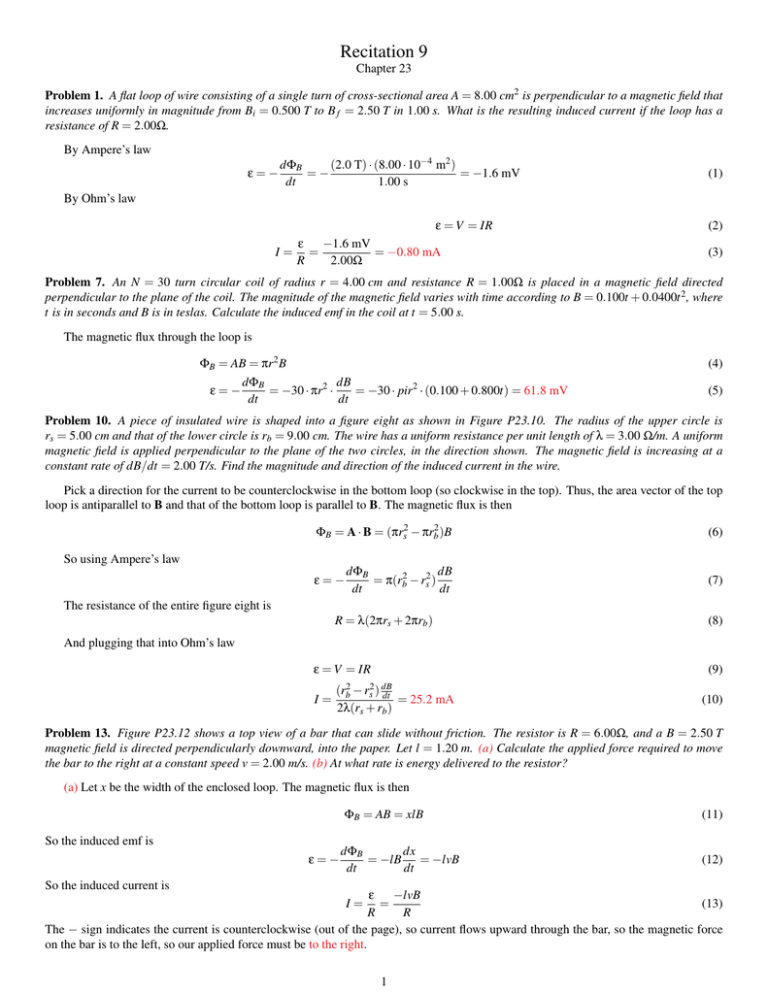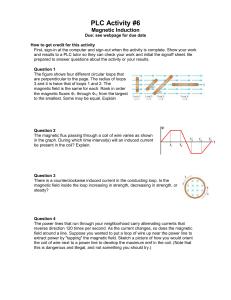Recitation 9
advertisement

Recitation 9 Chapter 23 Problem 1. A flat loop of wire consisting of a single turn of cross-sectional area A = 8.00 cm2 is perpendicular to a magnetic field that increases uniformly in magnitude from Bi = 0.500 T to B f = 2.50 T in 1.00 s. What is the resulting induced current if the loop has a resistance of R = 2.00Ω. By Ampere’s law ε=− dΦB (2.0 T) · (8.00 · 10−4 m2 ) =− = −1.6 mV dt 1.00 s (1) By Ohm’s law ε = V = IR I= ε −1.6 mV = = −0.80 mA R 2.00Ω (2) (3) Problem 7. An N = 30 turn circular coil of radius r = 4.00 cm and resistance R = 1.00Ω is placed in a magnetic field directed perpendicular to the plane of the coil. The magnitude of the magnetic field varies with time according to B = 0.100t + 0.0400t 2 , where t is in seconds and B is in teslas. Calculate the induced emf in the coil at t = 5.00 s. The magnetic flux through the loop is ΦB = AB = πr2 B dB dΦB = −30 · πr2 · = −30 · pir2 · (0.100 + 0.800t) = 61.8 mV ε=− dt dt (4) (5) Problem 10. A piece of insulated wire is shaped into a figure eight as shown in Figure P23.10. The radius of the upper circle is rs = 5.00 cm and that of the lower circle is rb = 9.00 cm. The wire has a uniform resistance per unit length of λ = 3.00 Ω/m. A uniform magnetic field is applied perpendicular to the plane of the two circles, in the direction shown. The magnetic field is increasing at a constant rate of dB/dt = 2.00 T/s. Find the magnitude and direction of the induced current in the wire. Pick a direction for the current to be counterclockwise in the bottom loop (so clockwise in the top). Thus, the area vector of the top loop is antiparallel to B and that of the bottom loop is parallel to B. The magnetic flux is then ΦB = A · B = (πrs2 − πrb2 )B (6) dB dΦB = π(rb2 − rs2 ) dt dt (7) So using Ampere’s law ε=− The resistance of the entire figure eight is R = λ(2πrs + 2πrb ) (8) And plugging that into Ohm’s law ε = V = IR I= (9) (rb2 − rs2 ) dB dt 2λ(rs + rb ) = 25.2 mA (10) Problem 13. Figure P23.12 shows a top view of a bar that can slide without friction. The resistor is R = 6.00Ω, and a B = 2.50 T magnetic field is directed perpendicularly downward, into the paper. Let l = 1.20 m. (a) Calculate the applied force required to move the bar to the right at a constant speed v = 2.00 m/s. (b) At what rate is energy delivered to the resistor? (a) Let x be the width of the enclosed loop. The magnetic flux is then ΦB = AB = xlB So the induced emf is ε=− dΦB dx = −lB = −lvB dt dt So the induced current is (11) (12) ε −lvB = (13) R R The − sign indicates the current is counterclockwise (out of the page), so current flows upward through the bar, so the magnetic force on the bar is to the left, so our applied force must be to the right. I= 1 The work begin done by the applied force is W = F · dx (14) So the power input from the force is W /dt dx F = Fv = dt All of this power must be dissipated by the resistor, so the current is PF = P = I2R r r r P P Fv = = I= R R R (15) (16) (17) We combine both current equations to yield r −lvB Fv = R R 2 (lvB) = RFv F= v(lB)2 R (18) (19) = 3.00 N (20) (b) Going back and plugging in F, PF = Fv = 6.00 W (21) Problem 22. A rectangular coil with resistance R has N turns, each of length l and width w as shown in Figure P23.22. The coil moves in a uniform magnetic field B with constant velocity v. What are the magnitude and direction of the total magnetic force on the coild as it (a) enters, (b) moves within, and (c) leaves the magnetic field. (a) As in Problem 13, dΦB /dt = wBv, so the induced current is I= ε −dΦB /dt −wvBN = = R R R (22) Where the − sign indicates it is counterclockwise (against the changing flux direction). And the force on the leading wires is F = Il × B = −I · Nw · Bî = −v(wBN)2 î R (23) (b) Once the coil is inside the magnetic field, the flux becomes constant, so there is no induced emf driving a current, and thus no net force on the coil. (c) The situation here is the inverse of that in (a), so the induced emf is clockwise, but the current through the portion of loop in the magnetic field is still up, so the force is unchanged. −v(wBN)2 F= î (24) R Problem 53. A particle with a mass of m = 2.00 · 10−16 kg and a charge of q = 30.0 nC starts from rest, is accelerated by a strong electric field, and is fired from a small source inside a region of uniform constant magnetic field B = 0.600 T. The velocity of the particle is perpendicular to the field. The circular orbit of the particle encloses a magnetic flux of ΦB = 15.0 µWb. (a) Calculate the speed of the particle. (b) Calculate the potential difference through which the particle accelerated inside the source. (a) For particles circling in a uniform, perpendicular magnetic field, v2 = qvB r mv = qrB Fc = m (25) (26) Letting τ be the period, from ∆x = v∆t we have τ= 2πr 2πrm 2πm = = = 69.8 ns v qrB qB (27) The inverse of our cyclotron frequency from Recitation 7. The flux and magnetic field give us radius by ΦB = AB = πr2 B r ΦB r= = 2.82 mm πB 2 (28) (29) So the speed is given by 2πr qB = v= τ 2πm r ΦB = 254 km/s πB (30) (b) Conserving energy 1 K = mv2 = q∆V 2 mv2 ∆V = = 215 V 2q (31) (32) Problem 64. A novel method of storing energy has been proposed. A huge, underground, superconducting coil, d = 1.00 km in diameter, would be fabricated. It would carry a maximum current of I = 50.0 kA through each winding of an N = 150 turn Nb3 Sn solenoid. (a) If the inductance of this huge coil were L = 50.0 H, what would be the total energy stored? (b) What would be the compressive force per meter length acting between two adjacent windings r = 0.250 m apart? (a) 1 UL = LI 2 = 62.5 · 1010 J (33) 2 (b) Because the radius of the loop is so much larger than the spacing between windings, we can ignore the curvature of the wires and treat them as infinitely long and parallel. Then the magnetic field of one at the location of it’s neighbor is B= µ0 I 2πr (34) And the force per unit length is F/l = IB = µ0 I 2 = 2000 N/m 2πr 3 (35)





